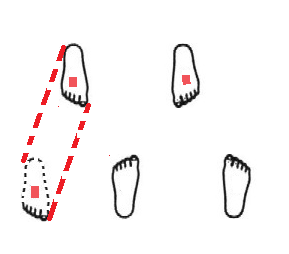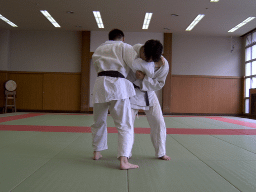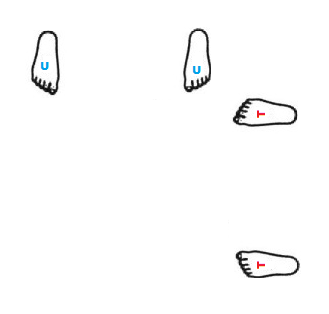[QUOTE=blackmonk;2826659]
LOL at the photo of Osoto Gari…I heard from one of my students that a kid at a clinic once asked Nic Gill how it felt to get thrown like that.
[QUOTE=blackmonk;2826659]Putting this here to continue discussion of o soto gari, outside of the derailed kani basami thread.
Continuing on that note, I (in a roundabout way) mentioned to BKR that the traditional entry worked in basic judo classes has never worked for me in randori, because most people will never let you drive in that direction without stiff-arming you away. The entry I’m speaking of is this:
So, as an adaptation, I have been taking a high-collar or shallow over-the-back grip, hooking their far leg while we are in a more square stance, and then “ken-ken”-ing around into throwing position. This worked almost 100% of the time in randori against varied opponents (white belts on up to black belts) until more recently, and now I’m either getting countered with tani otoshi or a half-assed ura nage, or I’m landing in a less-than-stable position on top. Still an ippon in judo and 4pts in sport sambo, but not advantageous in BJJ or freestyle sambo. In fact, I lost a match on an arguably bad call this past weekend off this very technique.
Nevertheless, I’m trying to figure out particulars on how to fix these problems.
I noticed in practice last night, after doing 100 full-force reps on the crash pad, that hooking at the lower calf or achilles lessened uke chance of stepping out or reversing the technique, because they weren’t able to fully engage their hamstring or create any significant force. I imagine this has to do with the leg acting as a lever, and the distance between the load (entire body) and length of the leg. The greater the disparity between the two, the more the effort required to move that load exponentiates.
I also noticed that crowning the head with the forearm of my collar or back grip side created a lot of unbalancing, sometimes to the point that the reap itself was secondary.
Thoughts, BKR? I will post video later tonight or tomorrow.[/QUOTE]
I haven’t seen or heard of hooking low as you describe, but in terms of the levers it of course makes sense. If you can make it work on skilled opponents, more power to you.
I’ll wait for video to see exactly what you mean. One question though: do you slide your “hooking” leg up once you have hopped into position, or just leave it low ? Because cutting behind the knee has some bio-mechanical advantage as well, especially if you have weight on uke leg.
I’m not sure what you mean by “crowning the head” (sounds like child birth to me, LOL). If you mean catching the side of the head instead of the neck with your arm, OK, that’s something I’ve done before in Osoto Gari. More commonly, the forearm is used if tori has gotten into position but left the tsurite behind.The forearm then goes under the chin and levers it up by bending the wrist and lifting the elbow. That gets uke head back. Otherwise, the Osoto Gari usually fails.
In the case of Jimmy Pedro’s example, I’ll just point out that he is a lefty, and so is demonstrating (I’ve seen him do it in person at a clinic and in shiai) a left vs right (kenka yotsu situation). That style of cross body Osoto Gari is/was fairly common way to attack due to the larger distance and the angles between uke and tori.
As an example of pitfalls, which come directly from the problems I had with the style of Osoto Gari entry you are working on, my problem was to keep the weight loaded on uke leg while I hopped into position, as well as head control (which are linked of course). You really need to freeze uke in place, or at least keep your balance ahead of his. Or get countered.
Finally, the experts that I’ve had instruction from emphasized hooking your heel behind uke knee, especially the outside ridge of the knee. All of them that did it to me put an incredible amount of pressure there which tended to paralyze me in place.


